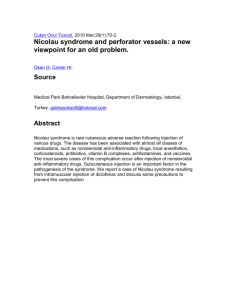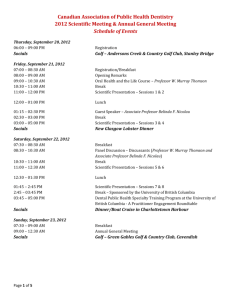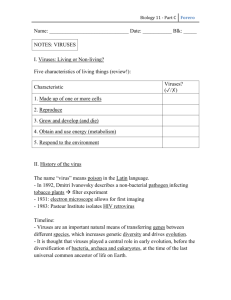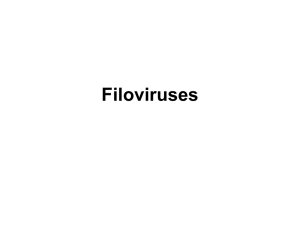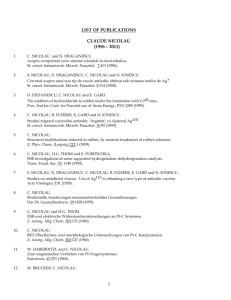document in format - Stefan S. Nicolau Institute of
advertisement
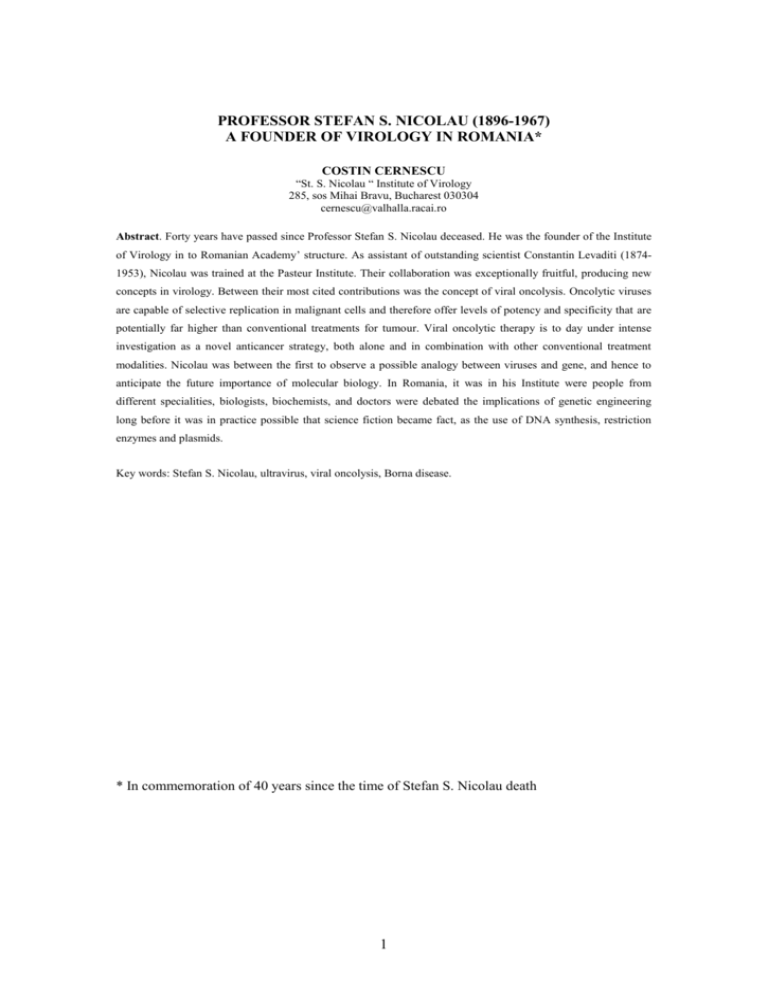
PROFESSOR STEFAN S. NICOLAU (1896-1967) A FOUNDER OF VIROLOGY IN ROMANIA* COSTIN CERNESCU “St. S. Nicolau “ Institute of Virology 285, sos Mihai Bravu, Bucharest 030304 cernescu@valhalla.racai.ro Abstract. Forty years have passed since Professor Stefan S. Nicolau deceased. He was the founder of the Institute of Virology in to Romanian Academy’ structure. As assistant of outstanding scientist Constantin Levaditi (18741953), Nicolau was trained at the Pasteur Institute. Their collaboration was exceptionally fruitful, producing new concepts in virology. Between their most cited contributions was the concept of viral oncolysis. Oncolytic viruses are capable of selective replication in malignant cells and therefore offer levels of potency and specificity that are potentially far higher than conventional treatments for tumour. Viral oncolytic therapy is to day under intense investigation as a novel anticancer strategy, both alone and in combination with other conventional treatment modalities. Nicolau was between the first to observe a possible analogy between viruses and gene, and hence to anticipate the future importance of molecular biology. In Romania, it was in his Institute were people from different specialities, biologists, biochemists, and doctors were debated the implications of genetic engineering long before it was in practice possible that science fiction became fact, as the use of DNA synthesis, restriction enzymes and plasmids. Key words: Stefan S. Nicolau, ultravirus, viral oncolysis, Borna disease. * In commemoration of 40 years since the time of Stefan S. Nicolau death 1 to isolate and cultivate as true microbes. INTRODUCTION Levaditi and Nicolau coined the term of In virology, ultravirus instead the label of “filterable circumscribed to the first half of a viruses” or “invisible viruses”, the label twentieth the used throughout the 19th century in France scientists as a blanket term for new, unorthodox, Constantin Levaditi and Stefan S. Nicolau infectious agents. In fact, Levaditi and played an important role. As faithful Pierre Lepine published the first textbook followers of Pasteur they assumed that of virology in 1938: “Les ultravirus des new filterable agents of infectious diseases maladies humaines”.2 It is to be noted that discovered by botanists (D.I. Ivanovski – the term “virology” became established in Tobacco by its own right only after the World War II veterinarians (F. Loeffler, and P. Frosch – with the apparition of the S. E. Luria’s foot and mouth disease) or by physicians classic manual “General Virology” (1953) (W. Reed, and J. Carroll – yellow fever; and of the first issue of the journal K. Landsteiner, and C. Levaditi1 - Virology (1955). contribution the history century of of sequence, Romanian Mosaic Disease), poliomyelitis) were small bacteria unable Fig.1. Jubilant “Nicolau” Medal awarded for excellence in PhD works at the Institute of Virology, Bucharest (a craftwork of outstanding Romanian sculptor Ion Jalea). 2 Nicolau was a natural organizer and, relationships), Elena Oprescu (respirtory together with Radu Portocalã and Nicolae viral Cajal, he began to recruit people to work (biochemistry of the viral nucleic acids), on isolation and cultivation of human and Dan Sarateanu (ornithoses), Constantin animal viruses. He developed a group of Surdan (Rickettsia), Nicolae Cajal - his devotees and students who adopted his succesor at the Institute and Chair of view points on the important problems of virology direction. The Institute bridges virus diseases of humans and domesticated the gap between clinical investigation and animals in parallel with research in the application of basic science in order to theoretical and experimental virology. understand infections), the Radu pathogenesis Portocala of the infectious diseases, their diagnosis and Stefan S. Nicolau founded the optimal Institute of Inframicrobiology of the control. management, prevention and Romanian Academy. The Institute has its origin in the nucleus of the Chair of SHORT BIOGRAPHIC NOTE Virology, which began its activity in 1942 in the framework of the Faculty of Stefan S. Nicolau obtained in Medicine in Bucharest. For the first time 1920 the MD degree at the Faculty of in the world, in the higher medical Medicine in Cluj, where he began this education, a separate discipline was collaboration with professor Moldoveanu. devoted to the study of the ultrafiltrable From his student years in Cluj, Nicolau infectious agents. Afterwards, a team of showed his tendency towards laboratory inframicrobiology of the Academy was research. After having spent one year in created, which developed into the actual Cluj, he began to work at Levaditi’s “Nicolau” Institute of Virology. The laboratory in the Pasteur Institute. Nicolau «Stefan S. Nicolau» Institute of Virology, studied for two decades at The Pasteur which chronologically is one of the first Institute in Paris (1920-1939). During this institutions in this speciality in Europe, interval he passed his PhD at Sorbonne has 50th (1925) and visited National Institute for anniversary of its foundation. Many Medical Research – London (1927-1931). disciples by He received many awards from Paris distinguished Academy of Sciences and also important themselves by significant contributions: prizes: Prize Bellion, 1926, Prize Breant, Adelina viral 1930, Prize Montyon, 1935. Out of the infections), Elisabeta Nastac (virus-cancer country until 1939, Nicolau authored celebrated professor of the in 1999 school Nicolau Derevic the created (respiratory 3 arbovirus infection7; the introduction of pioneering studies regarding viral diseases such as: herpes3, rabies4, poxvirus the synchronophylaxis concept, a fact 5, , which promotes him as a, precursor of the disease7, interference phenomenon description8; the Aujeszky’s disease, «looping illness» and discovery of the photodynamic action of others. stains (which is nowadays widely used in infections aphthous (especially fever, Among vaccinia) Borna the 6 worldwide acknowledged priorities we mention: the viral mutagenesis research on); the first detection of inclusions in the yellow description of the septic neuritis9 and fever – a diagnostic criterion of this others. . Fig 2. The office block of “Nicolau” Institute of Virology (www.virology.ro) In 1939, Nicolau returned in Iasi Medical School, and in 1942, as Romania as professor of Microbiology at professor 4 of Inframicrobiology at Bucharest Medical School. In the these objects by newly available electron microscope in the early 1940’. recognition of his outstanding publications he was elected member of Romanian In a broad prospective view of the Academy of Medical Sciences and of Romanian Academy. pathogenesis of viral infections, Levaditi He was director of the Institute of and Nicolau underlined the cell-mediated Inframicrobiology in Bucharest (to day, character of the antiviral immunity. Beside “St. S. Nicolau” Institute of Virology), the viral cytocidal effect, Nicolau revealed where he have the opportunity to create the participation of the cellular immune many independent laboratories in which response of the host in the triggering of the his co-workers served national public symptomatology. In a critical review of the literature health and medical school. As a teacher he was the editor of remarkable manuals on the antigenic translated in French, Russian, Chinese etc. ultraviruses, properties of Nicolau and the co-workers (1928)11 called attention to the fact that these agents of disease, as far as they have EARLY WORKS been studied, seem to exhibit antigenic In 1922, Levaditi and Nicolau properties which suggest placing them in published a series of articles in which new the general group of bacteria and other properties of the viral agents were more demonstrated: ultrafiltrability (passage bodies. They observed that vaccinia virus through pores collodion inoculated into the brain of an immunized membrane), antigenic properties of killed rabbit could not be demonstrated two and replicative viruses etc. Nicolau and hours after the injection. While vaccinia Levaditi elaborated experiments on the virus persisted in the circulation of a filterability of viruses with a very original susceptible rabbit for as long as 8 days and more constructive interpretation. They following opposed to the concept of non-particulate disappeared infective organism. In the debate about immune rabbit within 4 to 6 hours. whether the viruses were living or Nicolau and Kopciowska made a similar nonliving, or perhaps were the primordial observation stuff from which life itself originated, introduced into the brain of immunized Nicolau underscored the macromolecular rabbits7. nature of viruses and the significance of The same as the classic of Romanian their tiny component - the genomic nucleic medicine – Victor Babeº - Nicolau’ early acid. The structure of viruses was soon research works were connected with amply confirmed by direct observation of rabies. He described extremely important the of a 5 highly organized intravenous from proteinaceous infection, circulation regarding herpes of it an virus lesions in the central nervous system of Between the most cited Nicolau’ animal dead of rabies or of other publications were papers referring the role neurotropic viruses. Although described of by Victor Babeº as far back as 1886, the neurobehavioural diseases. Borna disease cytoplasmic inclusions in rabies were virus (BDV) is the prototype of the family given the name of “Negri bodies”.11 The Bornaviridae, genus Bornavirus, within priority of Babeº was recognized owing to the the well documented works of St. S. ribonucleic acid (RNA) viruses (order Nicolau and Mircea Babeº. Nicolau was Mononegavirales). Nicolau and Galloway the editor of two volumes of V. Babeº were the firsts to conduct experimental selected works and of many monographs study of Borna disease in sheep and cattle which created a true virology library in and describe the characteristics of this Romanian. (see books at the references) enzootic Borna virus nonsegmented infection in negative-strand encephalo-myelitis.13 This neurotropic virus appears to be distributed In regard to the immunological worldwide and has the potential to infect conditions existing in herpes disease, his most, if not all, warm-blooded hosts. The experiments have reaffirmed that herpes name Borna refers to the city of Borna, virus can be neutralized with the serum of Germany, the site of an equine epidemic in actively immunized animals and have 1895–1896 offered an explanation for the irregularity cavalry. of the results of others. Nicolau et al. reported primarily in Europe, but recent found that brain extracts from inoculated reports also include North America and rabbits possess some virus-neutralizing parts of Asia (Japan, Israel and Iran). power, but considerably less than the Reports serum control infected animals suggest that the virus animals. It has been shown that active may be more widespread than previously immunity can be attained only when some appreciated. Reports of BDV nucleic acid degree of reaction to the living virus has and occurred. mononuclear cells also indicate a potential of the corresponding Rabbits which survived neutralized serum-virus mixtures did not that crippled Natural of proteins infection the has asymptomatic, in Saxon peripheral been naturally blood for haematogenous transmission. acquire immunity nor did those treated Although there is consensus that with virus phenolized to the extent of humans are likely to be susceptible to actual destruction. 9 BDV infection, the epidemiology and clinical consequences of human infection remain controversial. After 1990, German THE MOST CITED WORKS scientists reported that Borna infectious virus has been isolated from humans. 14, 15 6 There have been no large controlled of general pathology. Thus, morphological prevalence data supported the viral etiology of some studies but methods for diagnosis of human infection were reliable cardiovascular diseases suggesting an association between BDV myocarditides)21 and neuropsychiatric disorders, including chlamydia, unipolar depression, bipolar disorder or herpesviruses in the etiopathogenesis of schizophrenia. BDV has also been linked some to chronic fatigue syndrome, spontaneous abortions.22 and the rickettsia congenital (arteritides, role and of some malformations and An innovative concept developed I shall detail my remarks to by Levaditi and Nicolau was viral Nicolau’ papers on the relations between oncolysis the viruses and cancer, published in the period neurovaccinal virus was inoculated into from 1960 to 1967, which I personally in grafted tumours. studies 16 where Sinkovics J.C., and consider highly significant. The author Horwath J17. (Viruses and cancer. Medical summarises the general properties of Hypotheses 1995, 44, 359-368.) quoted human from the paper of Romanian scientists: development “Tumours are more susceptible to viruses microbiology and proposes guidelines that than normal cells and tumours act as a might help to determine the role of viruses sponge attracting viral replication". This in human cancer. The work on the role of hypothesis is now in the centre of interest viruses in the pathogenesis of human for many biotechnology companies who cancer was hampered by the fact that enlarge cancer virotherapy models. virus-associated cancer develops only in a tumour viruses, of causal reviews the thinking in Stefan S. Nicolau made obvious small minority of infected subjects, which the theory of viral etiology of some implies that, if the virus does play a role in cancers. With a remarkable intuition the pathogenesis of the malignancy, other Nicolau promoted the hypothesis of the factors must be also involved. Naturally oncogenic potential of the viral nucleic oncolytic acids. He developed the infravirus model – competent viruses that have an innate the autonomized form of viral nucleic ability to selectively infect and kill tumour acids which, after its integration in the cells. Despite being used in the original host cell genome, contribute to the viral attempts to treat cancer with live viruses transformation and the occurrence of five decades ago, interest in naturally various morbid states. oncolytic viruses has lagged behind the The school of professor Nicolau viruses are replication- support for engineered adenoviruses and provided significant arguments for the herpesviruses involvement of viruses in the other fields Recently, 7 as cancer however, there therapeutics. has been renewed interest in the high potency and carcinoma); and animal T-cell Leukemia selectivity of these naturally occurring Viruses (bovine, 19, 20 agents. leukemias). used in murine T-cell The criteria most often determining causality were Levaditi and Nicolau were the first consistency of the association, either to study the action of a neurotropic strain epidemiologic or on the molecular level, of vaccinia virus on tumours of mice and and oncogenicity of the agent in animal rats. They found epitheliomas of these models or cell cultures.21, animals to provide an excellent culture most of the tumour viruses the viral medium for the virus in contrast to genome persists in an integrated or sarcoma. These findings were in accord episomal form with a subset of viral genes with their previous investigations where expressed in the tumour cells, some agents neurovaccinia (Hepatitis B virus) are not inherently ectodermal was rather shown than to have mesodermal oncogenic, tropism. but transformation Studying tumours infected with means.23, 24 22 Whereas for infection of cells leads by to indirect For some malignancies the neurovaccinia in immune animals Levaditi viral agent appears to serve as a cofactor and Nicolau showed that virus did not (Burkitt's lymphoma-EBV; mesothelioma survive in the immune host. If a portion of - SV(40)). For others the association is the tumour were transplanted into non- inconsistent (Hodgkin's Disease, breast immune animal, it would support growth cancer - EBV) and may either define of the infectious agent. The proliferative subsets of these malignancies, or the virus power of the transplantable tumour was may act to modify phenotype of an also interfered and is not always possible established tumour, contributing to tumour to make successful transplants from progression tumours carrying the vaccinia virus. tumour. Nicolau and his co workers In association rather than many with other causing the cases the malignancy is less developed investigations among many consistent or still emerging. For example, animal and human viruses that contribute despite the potent oncogenic properties of to a variety of malignancies.18 Between some strains of human adenovirus in tissue most studied viruses linked to cancers culture and animals the virus has not been were human papillomaviruses (cervical linked with any human cancers. Finally it carcinoma); polyomaviruses is likely that more agents, most likely (mesotheliomas, brain tumours); Epstein- viruses, both known and unidentified, Barr virus (B-cell lymphoproliferative have yet to be implicated in human cancer. diseases and nasopharyngeal carcinoma); In the meantime study of tumourigenic hepatitis human viruses (hepatocellular 8 5. infectious agents will continue to elucidate Levaditi C., and Nicolau S., Vaccine et neoplasmes. Ann. Inst. Pasteur, 1923, 37, molecular oncogenic processes. 443-447. 6. Viruses have been used for cancer Levaditi C., Nicolau S., Sur le culture du virus vaccinal dans les neoplasmes treatment for over a century. From the epitheliaux. Compt. Rend. Soc. Biol. early clinical studies with various wild- (Paris), 1929, 101, 334. 7. type viruses, to the modern trials with engineered emerged viruses, as a virotherapy Nicolau S. S. & Kopciowska L A new stain method. Compt. Rend. Soc. Biol. has (Paris) 1929, 101, 655-7 promising therapeutic 8. Nicolau S.S. & Kopciowska L. strategy.19 In a recent review, which also Persistence of rabies virus in vaccinated mentions Levaditi and Nicolau priority, animals. Compt. Rend. Soc. Biol. (Paris), japanese authors discuss the progress and 1932, 110, 348-351. challenges associated with 9. oncolytic note on the experimental study of enzootic virotherapeutic agents, summarizing the encephalo-myelitis (Borna disease) Br. J. data from clinical reports, and the Exp. Pathol. 1927, 8, 336-341. 10. Levaditi C. and, Nicolau S. S., Virus et implications of this data for future virotherapy development.25 Nicolau S.S., and Galloway I. Preliminary tumeurs. Ann Inst Pasteur 1923, 37, 1-3. Beyond 11. Nicolau S., Kopciowska L., Balmus G. historical perspective on the development Inclusions cytoplasmiques simulant les of oncolytic virus the reviewers present corps de Negri dans le cerveau de la the encouraging results of recent clinical souris normale. . Compt. Rend. Soc. Biol. trials (e.g., an modified herpesvirus has (Paris) 1933, 113, 851-855. 12. Nicolau S.S., Galloway I.A., Dimancesco- been tested in clinical trial of nearly 250 Nicolau O. « Étude sur les septinévrites à patients and approved for human use by ultravirus neurotropes » Masson, Paris, the Chinese FDA). 1929. 13. Nicolau S.S., and Galloway I. Borna REFERENCES 1. disease and enzootic encephalomyelitis of Landsteiner, K., and Levaditi C. La sheep and cattle. Spec. Rep. Ser. Med. transmission de la paralysie infantile aux Res. Council 1928, 121, 7-90. 14. Bode L., Dürrwald R., Rantam F.A., singes. Compt. Rend. Soc. Biol. (Paris). 2. 3. 4. 1909:592-594. Ferszt R. and Ludwig H. First isolates of Levaditi C., Lépine P., Blanc G., (eds) infectious human Borna disease virus « Les ultravirus des maladies humaines ». from patients with mood disorders. Librairie Maloine Paris, France, 1938. Molecular Psychiatry 1996, 1, 200–212. 15. Dittrich W., Bode L., Ludwig H., Kao M. Levaditi C., and Nicolau S., Affinite du virus herpetique pour les neoplasmes and Schneider K. Learning deficiencies in epitheliaux. Compt. Rend. Soc. Biol. Borna disease virus-infected but clinically (Paris), 1922, 87, 498-500. healthy rats. Biological Psychiatry 1989, 26, 818–828. Nicolau S., and Kopciowska L. Compt 16. St. S. Nicolau “Cancer and viruses”, Rend Soc Biol (Paris) 1922, 86, 563. 1955, Editura Academiei, Bucharest 9 17. Sinkovics J.C., and Horwath J., Viruses into an immunogenic virus under the and cancer. Medical Hypotheses 1995, action of copper. Acta Biol Med Ger. 44, 359-368. 1962, 8, 219-29. 22. Nicolau S. S. et al. Study on the rickettsial 18. Nicolau S.S., Cajal N., Schächter A., S r þeanu D., Cepleanu M., Sorodoc Y. etiology of various angiopathies. Rev Sci Les relations entre l'ornithose et la Med. 1963, 8, 69-73. 23. St. S. Nicolau “Viral hepatitis” 1960, maladie de Hodgkin. Archives of Editura Academiei, Bucharest. Virology ( Springer Wien) 1963, 13, 1432. 24. Nicolau S.S. Inframicrobial epidemic 19. Nicolau S.S., The oncolytic action of certain viruses. Stud Cercet hepatitis, the virus of the disease. Rom Inframicrobiol. 1960, 11, 529-48. Med Rev. 1961, 5, 19-23. 25. Kasuya H., Takeda S., Shimoyama Romanian. S., Shikano T., Nomura N., Kanazumi 20. St. S. Nicolau “Basic Inframicrobiology” (Elemente de Inframicrobiologie, N., Nomoto S., Sugimoto H., Nakao, A. Romanian, Russian, Chinese, 1956, 1962, Current Cancer Drug Targets 2007, Editura Medicalã, Bucharest. 7, 123-125. 21. Nicolau S. S. et al. Experimental investigations on the antirabies vaccine prepared under the action of copper ions. Contributions concerning the mechanism of transformation of the pathogenic virus Books 1. 2. 3. 4. 5. 6. 7. Şt. S. Nicolau HEPATITE INFRAMICROBIENE (“Viral hepatitis”) - Ed. Academiei R.P.R., Bucharest, 1954. V. BABEŞ (OPERE ALESE) („Selected works of Victor Babeº”) Vol. I – (Şt. S. Nicolau, M. Babeş, Fl. Horodniceanu, eds), Ed. Academiei R.P.R., Bucharest, 1954. V. BABEŞ (OPERE ALESE) (Selected works of Victor Babeº”) Vol. II - Şt. S. Nicolau, M. Babeş, Fl. Horodniceanu, eds), Ed. Academiei R.P.R., Bucharest, 1959. Şt. S. Nicolau CANCER ŞI VIRUSURI. CÎTEVA CONSIDERAŢII PRIVITOARE LA IPOTEZA VIROTICĂ A CANCERULUI („Cancer and Viruses – remarks on the cancer viral etiology”), Ed. Academiei R.P.R., Bucharest, 1955. Şt. S. Nicolau ELEMENTE DE INFRAMICROBIOLOGIE GENERALĂ („Basic inframicrobiology”), Ed. Academiei R.P.R., Bucharest, 1956. Şt. S. Nicolau (editor) PROBLEME DE INFRAMICROBIOLOGIE („Progress in inframicrobiology”)- coautori: Şt. S. Nicolau, N. Cajal, A. Derevici, C. Iacob, G. Marinescu, S. Mateescu, R. Portocală, D. Sărăţeanu, J. Schwartz, Ed. Medicală, Bucharest, 1956. Şt. S. Nicolau HEPATITELE INFECŢIOASE INFRAMICROBIENE 8. 9. 10. 11. 12. 13. 10 („Virus infections of the liver”)- Şt. S. Nicolau, Ed. Academiei R.P.R., Bucharest, 1957. Şt. S. Nicolau, Al. Rădulescu, N. M. Constantinescu, N. Cajal, G. Marinescu, POLIOMIELITA – („Poliomyelitis”), Ed. Academiei R.P.R., Bucharest, 1961. Şt. S. Nicolau, N. M. Constantinescu, N. Cajal. TURBAREA („Rabies”) - Ed. Academiei R.P.R., Bucharest, 1962. Şt. S. Nicolau (ed) ELEMENTE DE INFRAMICROBIOLOGIE SPECIALĂ („Infections of inframicrobial etiology”) – Ed. Medicală, Bucharest, 1962. Şt. S. Nicolau, N. Constantinescu RICKETTSII ŞI RICKETTSIOZE („Infections of rickttsial etiology”-, Ed. Academiei R.S.R., Bucharest, 1965. Şt. S. Nicolau, Elisabeta Nastac, VIRUSURI ŞI TUMORI („Viruses and tumours”) - Ed. Academiei R.S.R., Bucharest, 1968. Şt. S. Nicolau, N. Drăgănescu HERPESUL („Hepres viruses”) - Ed. Academiei R.S.R., Bucharest, 1968.
